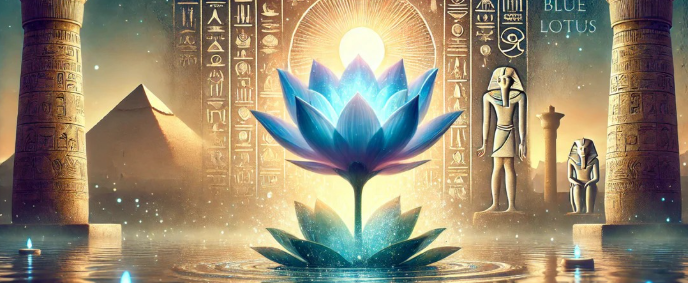The Blue Lotus dried flowers have fascinated humanity for thousands of years, celebrated not only for their mesmerizing beauty but also for their rich cultural, medicinal, and spiritual significance. Known scientifically as Nymphaea caerulea, the Blue Lotus—sometimes called the Egyptian Blue Water Lily—has played a profound role in ancient civilizations and continues to captivate modern herbalists, wellness enthusiasts, and spiritual seekers. This sacred flower, when dried, offers a variety of uses ranging from aromatherapy and tea making to ceremonial rituals and natural skincare.
In this article, we’ll dive deep into the history, benefits, preparation, and modern applications of Blue Lotus dried flowers, exploring why they are so cherished around the world.
Historical Significance of the Blue Lotus
The Sacred Symbol of Ancient Egypt
The Blue Lotus held divine symbolism in ancient Egypt, representing rebirth, enlightenment, and the eternal cycle of life and death. Depictions of the flower can be found in ancient Egyptian tombs, temples, and artworks—often shown in the hands of gods, pharaohs, and priests.
The Egyptians believed that the Blue Lotus had a powerful spiritual essence capable of inducing heightened states of awareness and connecting humans with the divine. It was often used during religious ceremonies and rituals to promote deep meditation and inner peace. The flower was also associated with the sun god Ra, as it would bloom during the day and close at night, symbolizing the journey of the sun and the soul’s rebirth.
Use in Ancient Medicine and Rituals
Apart from its symbolic meaning, ancient Egyptians also utilized the Blue Lotus dried flowers for their healing and psychoactive properties. Historical records and archaeological findings indicate that the flower was often infused in wine or water to create a mildly euphoric, relaxing beverage. This infusion was used to relieve anxiety, promote sleep, and enhance spiritual experiences.
Botanical Characteristics of Blue Lotus
Scientific Overview
The Blue Lotus belongs to the Nymphaeaceae family, a group of aquatic plants commonly known as water lilies. Nymphaea caerulea thrives in warm, shallow waters, especially along the Nile River and other parts of Africa and Asia. Its petals are a striking shade of deep blue to violet, radiating a calming, almost mystical energy.
Harvesting and Drying Process
To produce Blue Lotus dried flowers, the blooms are hand-harvested at their peak and carefully sun-dried or air-dried to preserve their delicate color, aroma, and active compounds. Proper drying ensures that the flowers retain their natural potency, aroma, and therapeutic qualities.
The drying process involves:
- Harvesting at sunrise – when the flower’s natural oils are most concentrated.
- Gentle cleaning – removing debris and water to prevent mold.
- Air drying – placing the flowers in shaded areas with good airflow to avoid loss of nutrients and color.
This meticulous process results in dried petals that can be stored for months while maintaining their essence and beauty.
Chemical Composition and Active Compounds
The Blue Lotus flower contains several naturally occurring alkaloids and flavonoids responsible for its unique effects. The primary active compounds include:
- Nuciferine – a natural alkaloid known for its calming and mildly sedative effects.
- Aporphine – a psychoactive compound that can produce mild euphoria and relaxation.
- Flavonoids – powerful antioxidants that help protect the body from free radicals.
These compounds work synergistically to provide both physical and mental benefits, making Blue Lotus dried flowers a valuable herbal ally.
Health and Wellness Benefits of Blue Lotus Dried Flowers
Promotes Relaxation and Stress Relief
One of the most celebrated effects of Blue Lotus dried flowers is their ability to calm the mind and body. The natural alkaloids in the petals interact with serotonin and dopamine receptors in the brain, promoting relaxation and emotional balance. Many people use Blue Lotus tea or incense as part of their evening routine to unwind after a stressful day.
Supports Restful Sleep
Due to its sedative and soothing properties, Blue Lotus is often used as a natural sleep aid. Drinking Blue Lotus tea or using the flower in aromatherapy before bedtime can help improve sleep quality and reduce insomnia.
Enhances Meditation and Spiritual Practices
For centuries, spiritual seekers have turned to the Blue Lotus dried flowers for their ability to open the third eye and deepen meditation. The gentle euphoric effects help quiet the mind, increase focus, and promote a sense of unity and peace. It is often burned as incense or steeped in tea during yoga, prayer, or spiritual rituals.
Natural Aphrodisiac and Mood Enhancer
The Blue Lotus has long been known for its aphrodisiac properties. Ancient cultures believed it could increase sensuality and emotional connection. The flower’s compounds may elevate mood, heighten awareness, and enhance intimacy.
Antioxidant and Anti-inflammatory Properties
Modern research suggests that Blue Lotus dried flowers contain potent antioxidants that support overall health. These antioxidants help combat oxidative stress, promote skin vitality, and reduce inflammation in the body.
Ways to Use Blue Lotus Dried Flowers
Blue Lotus Tea
One of the most common ways to enjoy Blue Lotus dried flowers is by making a soothing herbal tea. To prepare:
- Boil water and allow it to cool slightly (to about 90°C or 194°F).
- Add 1–2 teaspoons of dried petals to the water.
- Steep for 5–10 minutes, depending on desired strength.
- Strain and enjoy the calming, floral flavor.
This tea can be enjoyed on its own or combined with other herbs like chamomile or lavender.
Infused Wine or Elixir
In ancient Egypt, the Blue Lotus was often soaked in wine to create a ceremonial drink believed to connect the drinker with divine energy. Modern users replicate this by infusing dried flowers in red or white wine for 24–48 hours, resulting in a fragrant, relaxing beverage. (Note: consume responsibly.)
Aromatherapy and Incense
The pleasant, slightly sweet aroma of Blue Lotus makes it an excellent choice for incense, essential oils, and potpourri. When burned, the scent promotes tranquility and mindfulness.
Bath and Skincare
Adding Blue Lotus dried flowers to bathwater or homemade skincare formulations can nourish the skin and soothe the senses. The flower’s natural antioxidants help rejuvenate the skin and promote a youthful glow.
Precautions and Considerations
While the Blue Lotus is generally considered safe for most people, it’s important to use it responsibly. Overconsumption may cause mild drowsiness or dizziness. Pregnant or breastfeeding individuals should consult a healthcare provider before use. Additionally, ensure that any Blue Lotus product you buy is free from synthetic additives or contaminants.
The Modern Revival of Blue Lotus Dried Flowers
In recent years, Blue Lotus dried flowers have seen a resurgence in popularity as people turn toward holistic wellness and natural remedies. From herbalists to aromatherapists, many appreciate the flower’s blend of beauty, history, and healing potential. Whether used in tea, rituals, or skincare, Blue Lotus continues to symbolize serenity, spiritual awakening, and balance.
Conclusion
The Blue Lotus dried flowers are far more than a beautiful botanical—they are a bridge between ancient wisdom and modern wellness. Revered for their calming, euphoric, and healing effects, these delicate petals offer a natural way to relax, reflect, and reconnect with one’s inner self. Whether you’re drawn to their spiritual symbolism or their therapeutic properties, incorporating Blue Lotus into your daily life can bring harmony to both body and soul.


